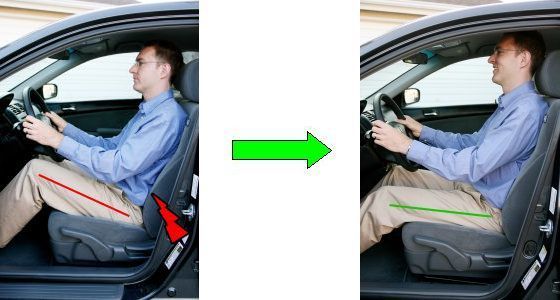Bruises Behind The Knees Because Of The Seat?
Topic 12465 | Page 2

In the two trucks I've been in at my CDL school, I can't reach the pedals because the seats don't move forward. I have to have 2 pillows on the backrest just so I can work the clutch. Hahahaha!
Hope you can figure it out. That sounds painful.
CDL:
Commercial Driver's License (CDL)
A CDL is required to drive any of the following vehicles:
- Any combination of vehicles with a gross combined weight rating (GCWR) of 26,001 or more pounds, providing the gross vehicle weight rating (GVWR) of the vehicle being towed is in excess of 10,000 pounds.
- Any single vehicle with a GVWR of 26,001 or more pounds, or any such vehicle towing another not in excess of 10,000 pounds.
- Any vehicle, regardless of size, designed to transport 16 or more persons, including the driver.
- Any vehicle required by federal regulations to be placarded while transporting hazardous materials.
Man, I really love this site. Seat adjustment is actually something I have been thinking about as school approaches. I'm 5'8" but have very short legs. Two of my exes are 5'0" and we never adjusted the car seat when we switched drivers. I've wondered about how to find the best adjustment if it isn't taught in school or training. I plan on spending as much time as possible behind the wheel without being miserable, and I know seat adjustment can have a big impact on long term comfort. I knew truck seats had more adjustments than a 4 wheeler, but I didn't realize in just how many ways. Thanks again to everyone for asking and answering questions, and all the advice and encouragement.

Old School pretty much summed it up, as did another poster. One of the best things I did for myself was learn how to adjust the driver's seat in a truck. Everybody is different, but if you cannot easily slip your hands under thighs, your sitting too high with too much air in the seat. I'm only 5'7", and yet I drive with ZERO air in the seat. I can see the road just fine. I sit low enough where I can't see the hood of the truck in a Freightliner Cascadia, but I can see the road plenty. It's fun to sit so high in a truck, but you don't need to have your seat jacked.
It took me a month of pins and needles and issues with my legs, plus a suggestion by a senior driver, to help me understand how important posture is for endurance. Truck drivers are prone to many health issues because of prolonged sitting. Adjusting your seat is paramount. Sit as low as you can while being able to slip your hands under your thighs. It'll save your legs.
You can also adjust the seat so that it slopes downward. It varies on truck models, but it's usually a twist knob on the right side. You'll need to lift yourself up off the seat to adjust it, but it basically controls how the seat tilts - incline, decline, or flat. Tilt it at a decline if you're still getting pressure under your thighs and back of your knees, even if you have your seat adjusted low without air.
Seat Ergonomics for the Common Person:

The main points (I bolded the answer to RV's question):
* Scoot the seat forward so you can reach and completely depress all the foot pedals without coming away from the seat back.
* Bring the back forward until you are reclined at a 100-110 degree angle. This decreases the pressure on the discs in your low back. Adjust your headrest so it rests in the middle of your head. Adjust the lumbar support so you have even back support. This should be supportive and comfortable. A lumbar cushion can be added if your car lacks sufficient lumbar support.
* Tilt seat cushion until it evenly supports your entire thigh without pressure in particular areas and does not hit the back of your knees. If it presses unevenly you can restrict circulation and cause discomfort in the legs.
* Adjust the seat belt to fit you instead of adjusting the seat to accommodate the seatbelt position.
New Reply:
New! Check out our help videos for a better understanding of our forum features

















Preview:








 TT On Facebook
TT On Facebook
Hi Vamp, Being a short dude myself, 5'5" I found I had to pull the seat all the way up (maybe one click back), and lower the seat down a lot. Its funny when I have to swap seats with a class mate after I drive ( I am the smallest guy in class at 150 lbs.), because when they jump in after my drive time, they sink that seat to the floor :-).
It does seem we loose some visibility when we lower the seat, but we need the balls of feet on the floor.
OOS:
When a violation by either a driver or company is confirmed, an out-of-service order removes either the driver or the vehicle from the roadway until the violation is corrected.